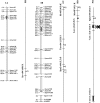Quantitative trait loci for grain yield and adaptation of durum wheat (Triticum durum Desf.) across a wide range of water availability
- PMID: 18202390
- PMCID: PMC2206097
- DOI: 10.1534/genetics.107.077297
Quantitative trait loci for grain yield and adaptation of durum wheat (Triticum durum Desf.) across a wide range of water availability
Abstract
Grain yield is a major goal for the improvement of durum wheat, particularly in drought-prone areas. In this study, the genetic basis of grain yield (GY), heading date (HD), and plant height (PH) was investigated in a durum wheat population of 249 recombinant inbred lines evaluated in 16 environments (10 rainfed and 6 irrigated) characterized by a broad range of water availability and GY (from 5.6 to 58.8 q ha(-1)). Among the 16 quantitative trait loci (QTL) that affected GY, two major QTL on chromosomes 2BL and 3BS showed significant effects in 8 and 7 environments, with R2 values of 21.5 and 13.8% (mean data of all 16 environments), respectively. In both cases, extensive overlap was observed between the LOD profiles of GY and PH, but not with those for HD. QTL specific for PH were identified on chromosomes 1BS, 3AL, and 7AS. Additionally, three major QTL for HD on chromosomes 2AS, 2BL, and 7BS showed limited or no effects on GY. For both PH and GY, notable epistasis between the chromosome 2BL and 3BS QTL was detected across several environments.
Figures









References
-
- Araus, J. L., T. Amaro, J. Casadeus, A. Asbati and M. M. Nachit, 1998. Relationships between ash content, carbon isotope discrimination and yield in durum wheat. Aust. J. Plant Physiol. 25: 835–842.
-
- Araus, J. L., J. Bort, P. Steduto, D. Villegas and C. Royo, 2003. a Breeding cereals for Mediterranean conditions: ecophysiological clues for biotechnology application. Ann. Appl. Biol. 142: 129–141.
-
- Araus, J. L., D. Villegas, N. Aparicio, L. F. Del Moral, S. El Hani et al., 2003. b Environmental factors determining carbon isotope discrimination and yield in durum wheat under Mediterranean conditions. Crop Sci. 43: 170–180.
-
- Basten, C., B. S. Weir and Z.-B. Zeng, 2005. QTL Cartographer. North Carolina State University, Raleigh, NC. http://statgen.ncsu.edu/qtlcart/.
Publication types
MeSH terms
Substances
LinkOut - more resources
Full Text Sources
Research Materials

